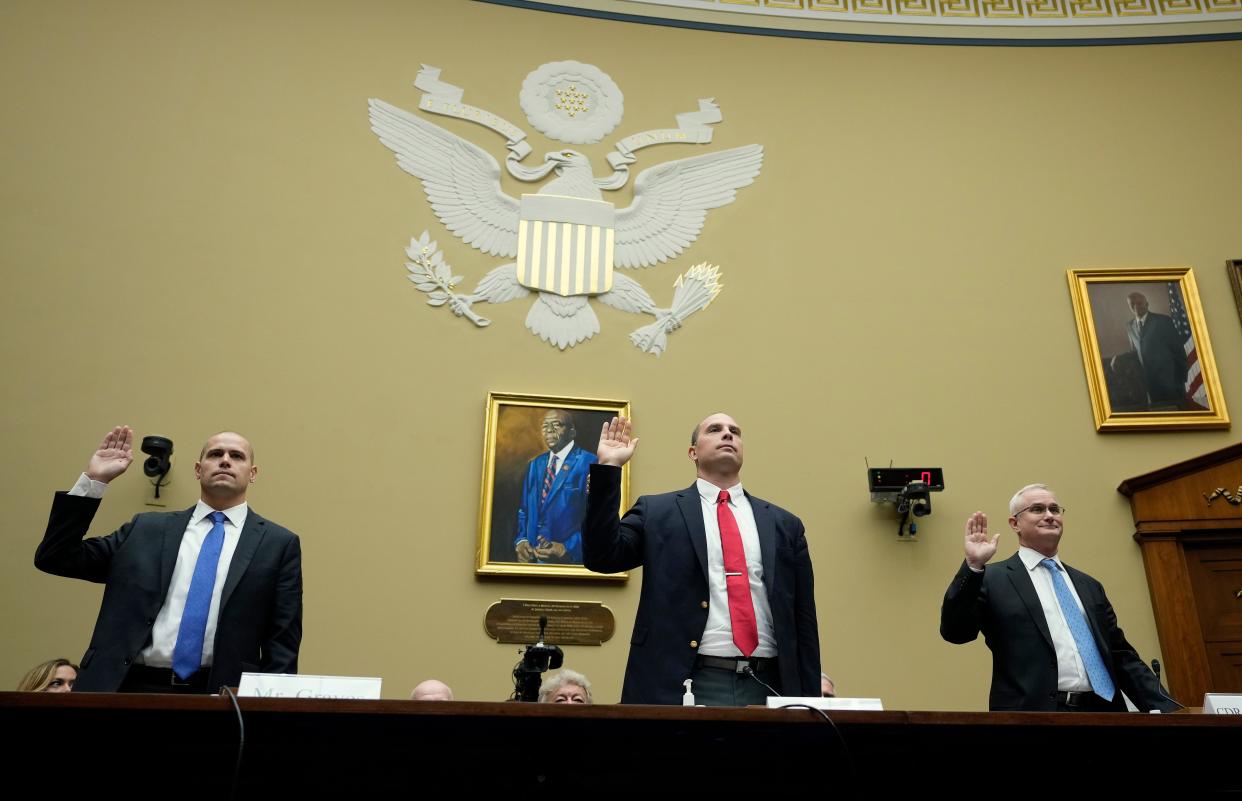Who is Ryan Graves? Former Navy pilot, UFO whistleblower has Central Mass. roots

A former F-18 pilot with ties to Central Massachusetts testified Wednesday before a U.S. House subcommittee hearing about his experience witnessing unidentified flying objects.
Ryan Graves, 37, is a former lieutenant in the U.S. Navy. Originally from Baldwinville, he graduated from Narragansett Regional High School in 2004 and earned a bachelor’s degree in mechanical and aerospace engineering from Worcester Polytechnic Institute in 2008.
Graves was commissioned with the rank of ensign in the Navy through the Officer Training Command in Newport, Rhode Island, according to 2009 article in the Gardner News.
He now lives in southern New Hampshire.
Graves said he was deployed in Operation Enduring Freedom, the official name for the Afghanistan War and larger War on Terrorism; and Operation Inherent Resolve, the official name for U.S. intervention against the Islamic State.
Wednesday, Graves testified before the House's Subcommittee on National Security, the Border and Foreign Affairs. He said he spoke on behalf of over 30 commercial air crew and military veterans who have confided similar encounters.
How Graves became an activist on unidentified aerial phenomena
In 2014, Graves said, he witnessed what he refers to as UAP, or unidentified aerial phenomena, while he was stationed at Naval Air Station Oceana in Virginia Beach, Virginia.
According to Graves, upgrades to jet radar systems led to unknown objects being detected in the airspace, and later tests and visual identification correlated the presence of UAP.
The encounters became so frequent that aircrew would discuss the risk of UAP as part of their regular preflight briefs, Graves said.
During a training mission, Graves said, two F-18s were split by an UAP that was described as a "dark gray, or a black cube inside of a clear sphere." While the squadron submitted a safety report, Graves said, there was no official acknowledgment of the incident.
"UAP are in our airspace, but they are grossly underreported," Graves testified. "These sightings are not rare or isolated, they are routine. Military aircrew and commercial pilots — trained observers whose lives depend on accurate identification — are frequently witnessing these phenomena."
Graves said a stigma exists around discussing UAP that silences pilots out of fear for repercussions. Recent government statements casting doubt on eyewitness testimony have contributed to that stigma, Graves added.
Graves said all UAP videos are classified as "secret" or above, which impedes the public's understanding and fuels distrust.
Subcommittee members 'very receptive' to testimony
In an interview with the Telegram & Gazette Wednesday, Graves said the members of the subcommittee were "very receptive" to his testimony about pilots struggling to report what they witnessed and his advocacy on behalf of witnesses.
"They asked very good questions and they seemed to understand the seriousness that this represents for our national security infrastructure," Graves said.
He said the training he went through as a pilot was rigorous and imparted much of the information about airborne vehicles that he used to assess the UAP. The objects he saw had unique flight mechanics, he said.
"It really just boils down to energy," Graves said. "As fighter pilots, energy management is what we do when we fight and these objects seem to have more or less unlimited energy. They appear to be able to be out there all day and perform very energy-intensive maneuvers at whim."
Graves maintained that documents or videos concerning UAP should not be classified because they may present a different narrative or a "fundamental truth." Classification is supposed to only be used for purposes of protecting national security or to keep the capabilities of other states or entities secret, Graves said.
On his own experiences with UAP, Graves said his squadron would typically observe objects "beyond visual range" and they would fly closer to them so the objects could be picked up by their camera systems.
The squadron had a hard time gaining a visual identification of the objects, but they eventually saw them in the near-collision incident with the two F-18s during the training mission.
UFOs have had a long history in the public imagination as the territory of science fiction stories of alien invasions and mysterious encounters. Graves said it is best to maintain an "agnostic" stance on the nature of the objects pilots have observed and take a hard look at the data surrounding these events.
About Americans for Safe Aerospace
Graves founded the nonprofit Americans for Safe Aerospace and has served as executive director since March, according to his LinkedIn page. Graves said the nonprofit is a haven for UAP witnesses.
According to his LinkedIn page, Graves has hosted the Merged Podcast since January. The podcast's website states it takes a "radically open-minded approach" to the latest research and theories on UAP and hosts interviews with those who have firsthand accounts of observing them.
Last year, Graves appeared on the popular podcasts the Joe Rogan Experience and the Lex Fridman Podcast to talk about his experience with UAPs and his advocacy.
This article originally appeared on Telegram & Gazette: Who is Ryan Graves? UFO whistleblower has Central Mass. roots

